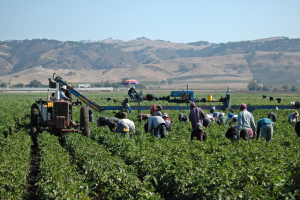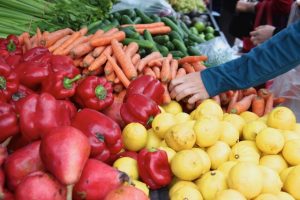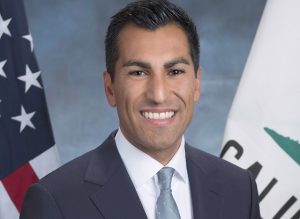The Urban-Rural Roundtable: Testimony before California’s State Board of Food & Agriculture
September 30, 2009 Michael R. DimockPresident Montna, Secretary Kawamura and distinguished members of the Board, thank you for inviting Roots of Change to share with you details about our Urban-Rural Roundtables project: the why, the how and the to where of that effort.
But before I begin, I want to take a minute to reflect on the relationship among this Board of agricultural leaders and the Roots of Change network, which now numbers 15,000 Californians. This is important because this relationship has been evolving for a couple of years now.
It was February 27, 2008 when I first came before the Board to describe ROC’s work and our hopes for the California Ag Vision process, which you were about to commence. It was my hope at that time to clarify that we had much more in common than some might think and that we could do much more together than apart. I think this same inclination was – and is – shared by members of the Board and the Secretary who has often spoken about the need to converge what heretofore have been parallel lines of activity.
Following my February 2008 visit, ROC did its best to bring people to the hearings you held up and down the state, to find supplemental funds from our core foundation supporters, and to convince many in the “sustainable agriculture and food systems” community that this Board and CDFA were onto something special and worthy of considerable time and effort. We are very glad we did this. The Ag Vision process continues to impress us and we remain steadfastly committed to making headway through that groundbreaking dialog.
Prior to Ag Vision and still today we also remain committed to the California Roundtable on Agriculture and Environment. We have, in fact, increased our investment from $20,000 to $40,000 per year, over the next 2 years in order to provide more support for work related to stewardship. We have also maintained a contract with Gus Schumacher, former Undersecretary of USDA, and authorized him under that contract to look for ways to provide California, particularly CDFA, with additional funds to implement its work. I know that Gus has worked with both Deputy Secretary Tse and Secretary Kawamura to identify sources of money.
But perhaps most importantly, we have invited to the Roots of Change Stewardship Council, our board, two members of your board, Luawanna Hallstrom and Adán Ortega, both of whom are valued and constructive members of the ROC Council. I want to thank Adán for his role in bringing me here today as well as his role in helping to launch our collaboration with Commissioner Daniels and the City of Los Angeles. I will soon be asking Luawanna for a similar hand in San Diego. This effort to link our organizations through leadership is a direct extension of our belief that dialog and practical collaborative work is the key to building understanding. It is a method to cross-pollinate and create intellectual hybrid vigor, if you will, which is what we need if we are to successfully negotiate the many challenges faced in this State related to agriculture, water, energy, environmental quality and human health.
So now let me turn to the Urban-Rural Roundtable effort.
First, let me share the why or the rationale for launching these roundtables. Those of you who had a chance to read our original report from the Vivid Picture project: will remember that it contained a section entitled: A Bold Agenda for Change. Within that section, there were three ideas for initiatives that ROC could launch to assist farmers and other food producers to prepare for the 21st Century. The first was The Best and the Brightest: A respected, competent, mission-driven leadership and workforce. The second was Get Fresh: Healthy, community-based food systems. And the third was A New Urban Rural Partnership: Linking communities, economies, and the environment. We have taken all three of these recommended initiatives to heart. The Urban-Rural Roundtables are obviously an outgrowth of that 3rd initiative.
The underlying concept for the urban-rural initiative is that the bifurcation of society between urban and rural is perilous. Allan Savory, the noted land steward and seminal thinker who developed the concept of holistic range management, has gone as far as to say that every civilization that lost touch with its total dependence on rural landscapes and rural peoples has eventually collapsed. It is hubris for cities to think they can ignore the value, values, needs and services of rural regions. Likewise, and I think your work with the agriculture industry around participation in the Ag Vision process indicates your agreement, rural communities also ignore at their peril the value, values, needs and services of urban regions. The urban-rural roundtables are ROC’s attempt to engage stakeholders in a dialog that reawakens both worlds to their interdependence.
Let me briefly recap how we describe this interdependence. The rural regions control the food supply and steward the natural environment as represented by the preponderance of the landmass. Within rural communities there exists deep knowledge about plants, animals and natural systems. The rural regions provide the water, energy and food sheds upon which our fate depends. In contrast, the urban regions control most of the votes, most of the financial power, and provide the largest markets for water, food and energy. They can also be seen a source of what was once considered waste, but are now considered resources, in the form of recycled water and compost. With this complimentary set of resources, the rational approach would be to enhance a robust exchange back and forth.
We believe we can highlight the potential of this circular resource flow in a way that brings more parity to the power dynamic. Rural regions need more investment in their health, wellbeing, and technological infrastructure. They need more influence over food, energy, and water pricing. In exchange, urban regions need enhanced stewardship of resources that have been degraded, even healthier food, provision of renewable energy, and more interaction with rural nature. Any attempt to create more visible and direct resource flows should mean new or enhanced economic activity, something this State needs.
Next let me turn to “how” or the way we conduct these roundtables. Obviously it would not be easy to spark a conversation with busy urban and rural leaders unless the potential for specific outcomes was clear. Let me use the example of the recently completed work in San Francisco to illustrate a couple of important points related to the process and ROC’s underlying strategy to create synergy in the system.
The San Francisco process began with the vision and leadership of Mayor Gavin Newsom, who was willing to undertake something not done before. The Mayor’s leadership was matched and reinforced by that of Secretary Kawamura. The Secretary showed extraordinary leadership because he engaged an atypical partner. I am sure you would all agree that a progressive mayor from a progressive city, who is running for Governor, could be seen by some in the more conservative parts of farm country as a person to avoid. But the Secretary saw the potential and committed himself to engage. With these two political leaders at the top, ROC was able – with assistance from the American Farmland Trust, SAGE, and the San Francisco Department of Public Health – to invite 50 leaders, 25 from the city and 25 from the country, to participate in a six-month iterative process. I direct you to page two of the Final Recommendation document to see the list of roundtable members.
To make the roundtable practical and potentially useful for all stakeholders, the Mayor tasked the Roundtable to develop an (and I quote) “integrated set of recommendations for programs, incentives, strategies, and practical actions”that the city could implement to “support the regional agricultural economy and increase the amount of high quality, California grown food for all”residents of the city, no matter their income level. So the idea was to build market access for producers and healthy food access for San Franciscans. This broad goal was enough spawn the hoped-for dialog.
We held three meetings. The first was in Davis in October 2008. The middle meeting was actually four committee sessions over two days in early January (3 were in Yolo County and 1 was in San Francisco). The last meeting was in San Francisco in March 2009. In between these three meetings, a team of experts, funded by ROC, worked to analyze and then synthesis the input of roundtable members. The final product was a set of five recommendations, which the Mayor used to create his Executive Directive 09-03, Healthy and Sustainable Food for San Francisco, which was issued on July 9, 2009, during the USDA sponsored, ROC Summit meeting dedicated to formation of sustainable foodsheds.
This is an historic document. According to messages we have received from London, New York and Chicago, each of which has headed down a similar road, and USDA representatives, San Francisco’s policy is the most comprehensive yet developed by a government body.
The directive recognizes the link between diet and health, farming and the environment, agriculture and quality of life. It calls for the city to focus on increasing access to healthy and sustainable food. In a key statement it states,
In our vision, sustainable food systems ensure nutritious food for all people, shorten the distance between food consumers and producers, protect workers health and welfare, minimize environmental impacts, and strengthen connections between urban and rural communities.
It calls for revision of the City’s Charter, General Plan and ordinances to make permanent its work to enhance the food supply of the residents of San Francisco. It seeks to maximize food production within the city and in the rural regions around the city. It calls for the City to focus its own purchases on foods certified as sustainable and to develop a promotional campaign that will encourage city-based private enterprise to purchase sustainable and regional food products. It directs the City to collaborate with entities seeking to protect farmland in the region. Most interesting to me, it directs the City to begin to advocate for State and Federal policies that align with the city’s desire to bring sustainable food to City residents. It is a groundbreaking document, setting a new bar for municipal and other governments.
Already, participants from the roundtable, both urban and rural have collaborated to seek funds and to organize a reverse trade mission, in which city buyers will be given tours of fruit, vegetable and nut farms a hundred or miles out into the City’s foodshed. And that is just the beginning. I know of at least two other efforts by roundtable participants to begin building on the work. For example, ROC has been invited by a foundation, previously unaffiliated with ROC, to request funds to support the City as it begins to advocate for State and Federal policies that will accelerate the development of a regional foodshed.
ROC has just received our first outside evaluation report, which is a case study of the roundtable process. This document, which will become public, clarifies, the large amount of language that was first offered in the Final Recommendations and which subsequently landed in the Executive Directive. We know from this objective analysis that the roundtable process was influential.
But this brings me to the second point I want to make. It is a point about our approach to change and the concept of synergy. To be precise, let me offer the definition we are using for synergy:
1. The interaction of two or more agents or forces so that their combined effect is greater than the sum of their individual effects.
2. Cooperative interaction among groups…that creates an enhanced combined effect. [From Greek sunergi_, cooperation, from sunergos, working together.
The San Francisco Urban-Rural Roundtable is probably the clearest example of how ROC is trying to both build and use synergy.
This particular example begins with the fact that for many years Columbia Foundation, a founder and core funder of ROC, has invested money in an organization called San Francisco Food Systems, which worked in support of the San Francisco Department of Public Health. That organization, which was originally run by Paula Jones, worked on innovations related to food access, farmers markets, purchasing for schools, coordination of actors who work on food systems in the City, and specific city policy ideas. Because of that innovative work, by 2006, Paula clearly became the go-to-person on food policy within the ecosystem of City government. She was in fact hired by the City’s Department of Public Health in late 2007. Paula became a key member of the ROC Roundtable expert team, along with others who were ROC Fellows: Holly King, Larry Bain, and Hannah Laurison. So the roundtable leveraged the early investments of Columbia Foundation, the work of Paula Jones, and the relationships of ROC with its Fellows. The Roundtable process strengthened Paula’s efforts within City government to have a policy adopted, by offering five recommendations that made her draft policy more comprehensive and by providing the Mayor a platform for offering political leadership.
The essence of our approach is to link leaders and spawn cross sector activity through our Fellowship program, our on-line network, and face-to-face convenings. We are also attempting to popularize new food system concepts. One of particular relevance is foodshed. In the documentation and convenings of the roundtable and later in July with our USDA sponsored, Sustainable Foodshed Summit, ROC offered an actual definition for foodshed and a foodshed management plan.
Now I will turn to the future of the program, to where we will go next. Earlier this year, ROC applied to the Risk Management Agency of USDA to fund development of two more roundtables, one in Los Angeles and one in Fresno. Risk Management accepted our proposal’s hypothesis that risk management is more than just market diversification and insurance programs. It is also about increasing the urban population’s understanding of the realities of farming and ranching, the vital need for fresh food, and building urban support for peri-urban and rural agriculture.
We have received $200,000 from Risk Management, which includes funds to launch two new roundtables. We will begin that work next month. Joseph McIntyre’s team from Ag Innovation Network will manage the Fresno roundtable and ROC is currently seeking a second team for Los Angeles.
As you will hear, Commissioner Daniels and the City have undertaken the effort to form a food policy council that will create a food policy for the city. ROC is serving that effort by conducting three urban-rural roundtable sessions that will offer recommendations to the Commissioner’s team. We are again drawing on the expertise and commitment of the ROC network to help inform those roundtable meetings. Both The Los Angeles City Task Force and the ROC Urban-Rural roundtables will include members from the Ventura County Ag Futures Alliance, the ROC Stewardship Council, and ROC Fellows.
With three roundtables complete or in process, we are poised to begin to prepare for similar work in the last three of the State’s largest metropolitan areas: San Jose, Sacramento and San Diego. In the end, we believe an appropriate and effective way to improve food and farming system is to create demand for sustainable products. Most people live in these six regions and these cities command nearly $500 million in direct food buying power and could influence billions of consumer dollars if they were to encourage their citizens to focus on regional and sustainable foods.
Finally, if the remaining five cities, commit as San Francisco has, to begin advocating for State and Federal policies that support sustainable food production, it could have major impacts. Until now, city governments have confined their food issue lobbying to SNAP and WIC issues. If they now begin to support rural stewardship of resources, urban food production capacity, renewable energy production, food processing infrastructure, municipal water reuse for food production, and agricultural land protection in the areas they see as foodsheds, the political dynamics could change.
ROC’s commitment is to maximize the understanding of municipal leaders so that new policies and positions are sensitive to the need for a steady and measured transition in which producers are provided the resources and opportunities that will be required to allow a rapid evolution of operations rather than chaos that could harm food production and rural communities.
With the six largest cities as allies, we believe the State’s effort to render a sustainable system by 2030, becomes much more likely. We hope we can continue to share information and collaborate with you all, and the Secretary in the implementation of the next five roundtables.
Thank you for your time.



